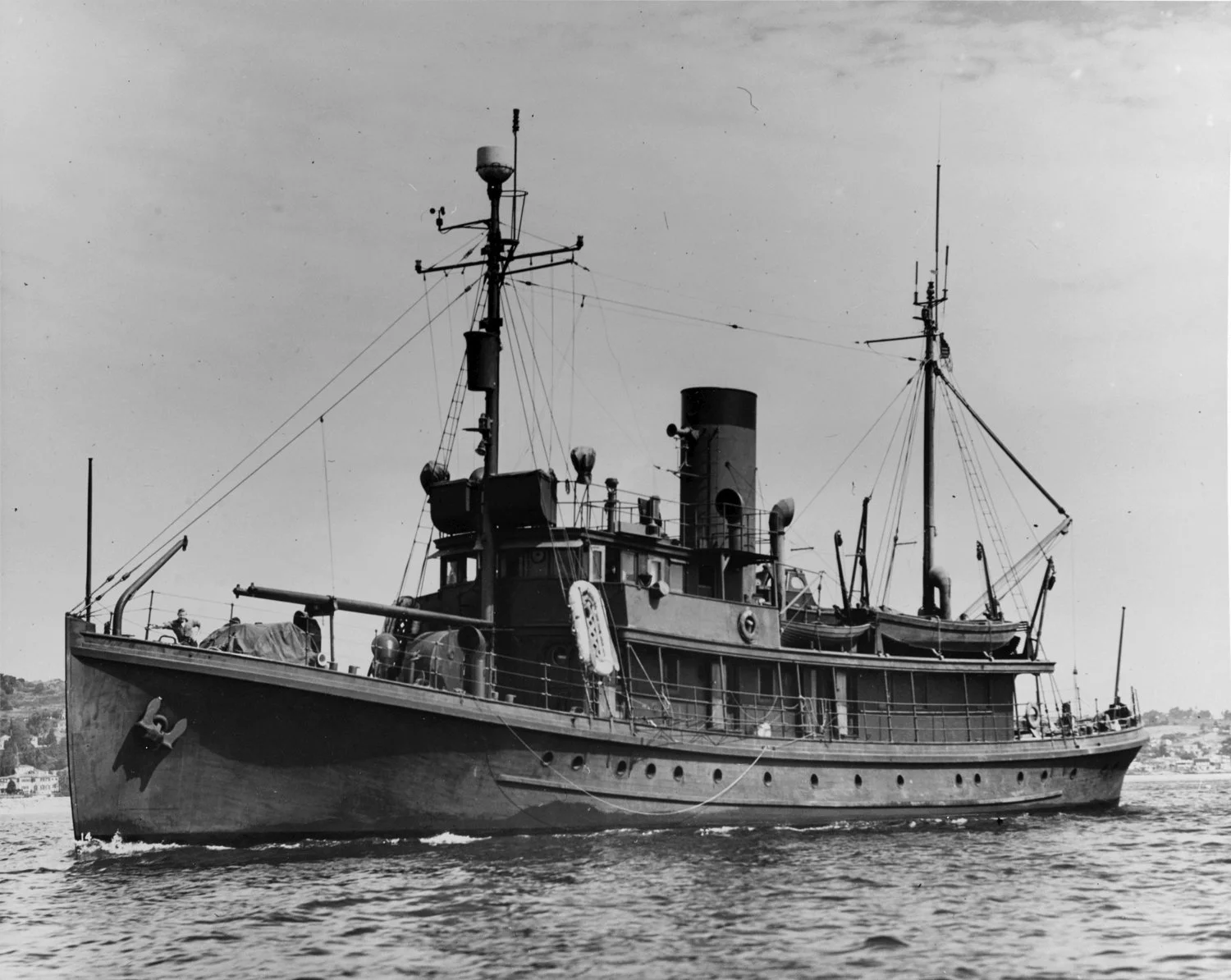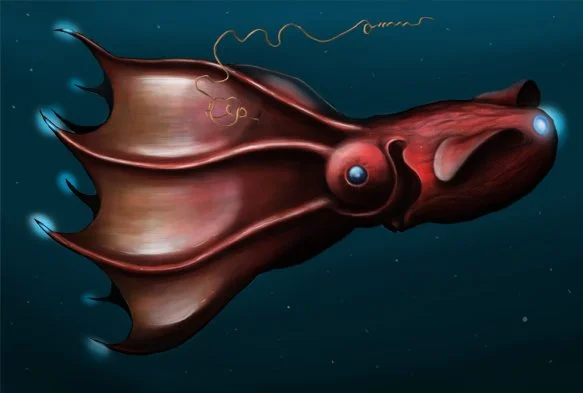Stories of the Sea: Fishing in the Twilight Zone
By Safina Center Fellow Raffi Khatchadourian
A photograph of the USS Jasper, circa 1945. Courtesy of Ted Stone, 1977. U.S. Navy photo NH 86368
In the spring of 1942, shortly before the United States entered World War II, a three-hundred-ton Naval vessel named the USS Jasper set out from the coast of Southern California into the Pacific, to test technology that the military hoped would assist in combating Nazi U-boats. The system, called “long-range active sonar,” involved a sonic projector that could beam focused vibrations to the ocean floor, and a sensitive hydrophone that could pick up the reverberations as the sound echoed back to the ship. The acoustical data could then be made visual, on an oscillograph, offering a map of the unseen depths.
The Navy technology, it turned out, was effective. But it also generated a puzzling finding: floating three thousand feet above the seabed, there appeared to be a second ocean floor—a phantom layer that was inexplicably scattering the Jasper’s sonic beams. The layer was shifting in and out of a part of the deep ocean known as the mesopelagic or “twilight” zone. It rose at sunset. It sank at sunrise.
The Jasper’s scientists were so mystified they wondered if their equipment was faulty. But in 1946, a different team confirmed their findings. The phantom layer, it appeared, was real. Eventually, the scientists concluded that the sonar was detecting countless “life forms” engaged in daily migrations on an unimaginable scale. What type of life? The Jasper’s crew had no idea: their technology could only tell them something was there; they weren’t equipped to make an “identification of the scatterers.”
We now know much more about the hidden creatures living at such great depths. They inhabit a Stygian realm where sunlight barely penetrates, and water pressure can exceed a thousand pounds per square inch. With odd morphology and exotic names (vampire squid, lanternfish), they have evolved in ways to survive extremity. Some are long and gelatinous, extending more than a hundred feet. Some are luminescent. Some resemble the stuff of nightmares. Many are small, shimmering, and bounteous. According to the folks at Woods Hole, “A tiny but fierce-looking fish called a bristlemouth is the most abundant vertebrate on the planet—for every one human, there are more than 100,000 bristlemouths.”
Organisms inhabiting the mesopelagic zone.
Clockwise from top left: Benthocodon jelly ©MBARI, Viperfish ©Jeff Drazen, Lanternfish ©Jeff Drazen, Appendicularian and mucus house © MBARI, Cranchiid squid ©MBARI, Sapphirina ©Erica Goetze/Katja Peijnenburg.
It might seem strange that a part of the Earth so distant and unlike our own is so teeming with life, but there are likely more fish in the twilight zone than in the rest of the ocean combined, with a collective biomass in the billions of tons. Perhaps, it was inevitable, then, that people would one day consider this vast, forbidding, but incredibly rich, ecosystem as “the next fisheries frontier.” By one estimate, it is “the world’s largest unexploited natural resource with a global biomass of 1 gigaton.”
But can the inhabitants of the deep be fished to meet humanity’s food needs? Should they be?
Such questions are being asked with greater frequency, as research initiatives in multiple countries have started to explore the feasibility of mesopelagic fishing. The challenges are immense. Fishing in the deep is hard to do efficiently, and it is expensive. (One commercial attempt, by the Soviet Union, to harvest tiny mesopelagic lanternfish at scale in the southern Atlantic and Indian ocean, ended in failure). Creatures in the twilight zone are often fast-moving, tend to dive when a vessel approaches, and are hard to differentiate from afar. They are also fragile: once hauled onto a ship, many disintegrate almost immediately—some into goop. And even if they can be quickly preserved, it is hard to imagine them on a plate, either because of their weird consistency, their oiliness, or their off-putting taste.
Norway’s Institute of Marine Research recently invited a celebrity chef to cook up krill and a tiny mesopelagic fish, called Mueller’s pearlside, for a dish that might be served in a restaurant. The krill apparently tasted good. The Mueller’s pearlside, eaten in large quantities, reportedly acted like a laxative. “It tastes really bad,” Runar Solstad, a researcher with Nofima, another Norwegian institute, told Hakai magazine. “There is no other way of putting it.” Solstad has sought to use enzymatic hydrolysis to alter the flavor of Muller’s pearlside, so that it might be made into a palatable dried snack. But the most likely use of such fish would be as ground-up feed for other animals that humans do regularly eat. Protein is fungible: a vampire-squid slurry can, theoretically, become a salmon steak.
Illustration of an adult vampire squid. ©Citron / CC BY-SA 3.0
This May, a piece in Mongabay on mesopelagic fishing indicated that the increasing demand for fishmeal—“heavily used in the aquaculture industry, which provides about half the world’s fish supply”— might drive humanity to develop commercial catches at greater ocean depths. Climate change, in addition to over-exploitation, could well add additional incentives to do so: in July, the Food and Agriculture Organization published an assessment on ocean resources, and it noted that “global projections of exploitable fish biomass show declines of more than 10 percent, particularly under the high-emissions scenario, by midcentury.” By the end of the century, it could be as much as 30 percent. Such declines would only compound existing stresses on the oceans, with as much as a third of global fish stocks currently over-exploited, by FAO estimates—a “continuous increasing trend” since 1974.
Under these circumstances, it is not hard to imagine greater government investment in efforts to overcome the technical and market challenges standing before fishing in the deep sea. But the consequences of commercial exploitation—of, effectively, transferring the vast amount of biomass from the twilight zone into farm-raised fish, or even to land animals—remain unclear. For one thing, the twilight-zone ecosystem is thought to work like an ecological pump, capturing and sequestering enormous amounts of carbon. As Ken Buesseler, a geochemist at Woods Hole, has noted, “If you turned off this biological carbon pump—let’s say, you somehow made the ocean sterile and sucked out all of the twilight zone’s organisms—you would more than double the amount of CO2 in the atmosphere that humans have added. That would take us to temperatures we haven’t seen in 50 million years.”
How many fish could humanity remove from the twilight zone without causing catastrophic effects on the atmosphere, or on other marine populations that feed on them? The answer is not really known. At least one group has called for a moratorium on mesopelagic fishing until the science is clear.
In reading about this issue for this blog post, I couldn’t help but think about an observation made by Daniel Pauly and several colleagues, in the late nineties, in a six-page paper in Science, titled “Fishing Down Marine Food Webs.” They noted then that catch statistics between the 1950s and the 1990s, in different parts of the world, revealed a disconcerting pattern: once large, long-lived ocean predators had been over-exploited, humanity tended to pursue animals further down the food chain. Fishing in the twilight zone, if it is commercially realized, may turn out to be the ultimate example.



